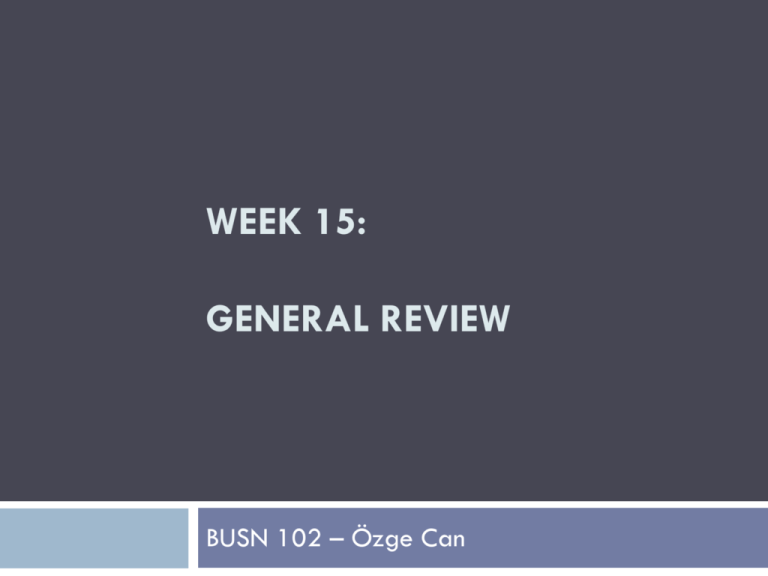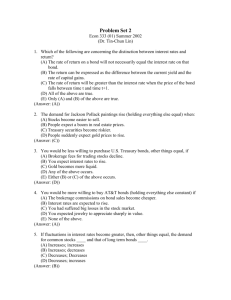Example Questions
advertisement

WEEK 15: GENERAL REVIEW BUSN 102 – Özge Can Final Exam 2 Format: Multiple-choice questions (%60) Short essays (%40) Content: Product and pricing strategies (Chp.14) Distribution and logistics (Chp.15) Customer communication (Chp.16) Accounting (Chp.17) Financial management (Chp.18) Key Topics 3 Key product types The product life cycle Product development process Branding and product mix Pricing strategies Contributions of intermediaries Major types of wholesalers and retailers Distribution channel decisions Market coverage Key Topics 4 Attributes of social communication model Communication strategy and mix Custumer communication channels Advertising, direct marketing, personal selling, sales promotions, social media, public relations Fundamental accounting concepts Three financial statements Components of balance sheet Components of income statement Key Topics 5 Types of financial ratios: Profitability, liquidity, activity and leverage (debt) Major tasks of financial managers Budgeting process and four budget types Comparison of debt and equity financing Alternatives of short-term financing Alternatives and long-term financing Example Questions: 6 ________ are particular brands that the buyer especially wants and will seek out such as professional violin lessons. A) Specialty products B) Capital items C) Convenience products D) Shopping products Example Questions: 7 The maturity stage of product lifecycle is ________. A) a stage where a product's price is at a high level B) usually the shortest stage in a product's lifetime C) characterized by steep decline in profits D) a stage where firms have to win sales away from competitors Example Questions: 8 During the business analysis stage, a company ________. A) sells the product on a limited basis to gauge its market appeal B) reviews the sales, costs, and profit projections C) screens the business ideas that it has generated D) generates a wide variety of ideas to introduce a new product Example Questions: 9 A group of fifteen entrepreneurs starts a manufacturing firm. The total fixed costs that they have incurred in setting up the business amounts to $50000. The variable cost of selling a unit of product is $25. What is the break-even point if each unit is priced at $50? A) 2000 B) 500 C) 666 D) 1000 Example Questions: 10 Which of the following pricing methods is characterized by charging a high price for a new product during the introductory stage and lowering the price later? A) cost-based pricing B) value-based pricing C) skim pricing D) penetration pricing Example Questions: 11 Wholesalers differ from retailers in that wholesalers ________. A) sell products to organizational customers B) are marketing intermediaries C) primarily sell products to consumers for personal use D) create place utility and time utility Example Questions: 12 When the role of an intermediary is taken over by manufacturers upstream or customers downstream, ________ occurs. A) centralization B) disintermediation C) market penetration D) horizontal integration Example Questions: 13 Stores that carry only a particular type of goods, often with deep selection in those specific categories, are called ________. A) department stores B) distributors C) specialty stores D) convenience stores Example Questions: 14 Intensive distribution differs from selective distribution in that intensive distribution ________. A) offers products in only one outlet in each market area B) tries to place a product in as many outlets as possible C) refers to producers that sell directly to consumers D) involves selling through a limited number of outlets Example Questions: 15 The new social model of customer communication differs from the conventional promotion model in that the social communication model ________. A) is unidirectional and intrusive B) is hierarchical and static C) views audiences as passive recipients of messages D) is interactive and conversational Example Questions: 16 Push strategy differs from pull strategy because in push strategy a producer ________. A) appeals directly to end customers B) uses integrated marketing communications C) focuses on wholesalers or retailers D) uses reminder advertising Example Questions: 17 The ad that tells you to "call within the next ten minutes because supplies are limited" is using advertising appeal based on ________. A) logic B) emotion C) humor D) scarcity Example Questions: 18 Direct marketing differs from advertising in that direct marketing ________. A) is carried by someone else's medium B) promotes the features and benefits of specific products C) involves the purchase of time or space in other media D) often uses personally addressable media Example Questions: 19 Luminescent Inc. manufactures and sells products related to surfing, skateboarding, and snowboarding. During Christmas, the firm gave free sports bottles with a Luminescent logo to all its customers, with the aim of keeping the firm's name in front of customers for a long period of time. This is an example of ________ advertising. A) institutional B) comparative C) specialty D) cooperative Example Questions: 20 Which of the following refers to evaluating a company's performance and the economic implications of strategic decisions such as product pricing, employee benefits, and business acquisitions? A) financial analysis B) tax accounting C) bookkeeping D) cost accounting Example Questions: 21 Public accountants are professionals who provide ________. A) accounting services to businesses and individuals for a fee B) financial services to not-for-profit organizations C) financial services without charging a fee for them D) financial services to people who trade in the stock market Example Questions: 22 ________ is an accounting method in which revenue is recorded when a sale is made and expense is recorded when it is incurred. A) Cash basis B) Accrual basis C) Profit basis D) Deferral basis Example Questions: 23 Which of the following statements is true of the order in which assets are listed in the balance sheet? A) Assets such as property and plant are mentioned first in a balance sheet. B) Fixed assets are listed before current assets in a balance sheet. C) Current assets are not generally mentioned in a balance sheet. D) Assets are listed in descending order by liquidity in the balance sheet. Example Questions: 24 The profit earned or loss incurred by a firm, determined by subtracting expenses from revenues, is referred to as the ________. A) working capital B) gross profit C) net income D) net sales Example Questions: 25 Activity ratios analyze ________. A) how well a company is making use of its assets B) a firm's ability to pay its short-term obligations C) a firm's ability to pay its long-term obligations D) the extent to which a business is financed by debt Example Questions: 26 Which of the following is the best example of an external source for obtaining funds for business? A) revenue from selling assets B) funds from shareholders C) earnings from investments D) issuing corporate bonds Example Questions: 27 X Learning company identifies the training needs of organizations and designs flash-based online training programs for them. The company has recently received an order to create product training platforms for an electronic manufacturer. The company creates a budget specifically for this order to determine the pricing of the project. This budget is an example of a ________ budget. A) operating B) capital C) project E) start-up Example Questions: 28 ________ is an arrangement in which a financial institution makes money available for use at any time after the loan has been approved. A) Corporate bond B) Factoring C) Line of credit D) Lease agreement Example Questions: 29 Frost Bank lends $500,000 to Arbex Manufacturer. Arbex has agreed to pay this amount back in fifty equal installments over a period of ten years. This is an example of a ________. A) lease agreement B) trade credit C) corporate bond D) long-term loan Securities 19-30 Securities Investments such as stocks, bonds, options, futures, and commodities 1) Stocks 19-31 Stock Ownership of or equity in a company A share of stock represents a specific portion of ownership Two major forms of stocks: Common stocks Preferred stocks Types of Stock: 19-32 Common Stock Shares of ownership that include voting rights Preferred Stock Shares of ownership without voting rights but with defined dividends 2) Bonds 19-33 Bonds are issued by corporations and various government bodies to raise funds Three key variables: Face Value: The amount of money, or principal, a bond buyer lends to a bond issuer; also known as par value or denomination Maturity Date: The date on which the principal of a bond will be repaid in full Yield: Interest income a purchaser receives from the bond Several Types of Bonds: 19-34 Treasury bills Treasury notes Treasury bonds Municipal bonds 3) Mutual Funds 19-35 Portfolio Diversification Spreading investments across enough different vehicles to protect against significant declines in any one vehicle Mutual Funds Financial instruments that pool money from many investors to buy a diversified mix of stocks, bonds, or other securities 4) Derivatives 19-36 Derivatives Contracts whose value is derived from some other entity (usually an asset of some kind, but not necessarily) Used to hedge against or speculate on risk Two major types of derivatives: Options Futures Financial Markets 19-37 Stock Exchanges Organizations that facilitate the buying and selling of stock Bond Market The collective buying and selling of bonds most bond trading is done over the counter, rather than in organized exchanges Financial Markets 19-38 Money Market An over-the-counter marketplace for short-term debt instruments such as Treasury bills and commercial paper Derivatives Market A market that includes exchange trading (for futures and some options) and over-the-counter trading









